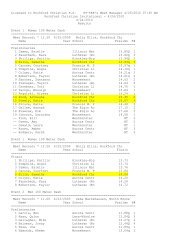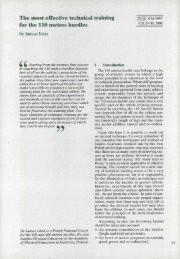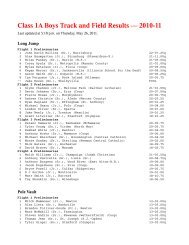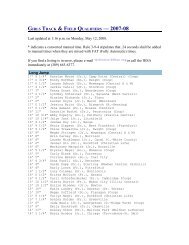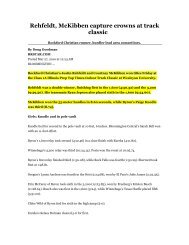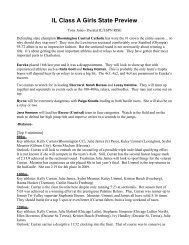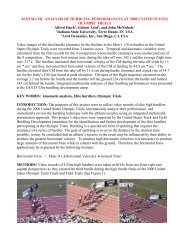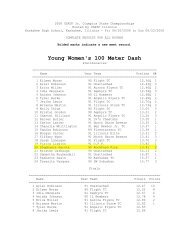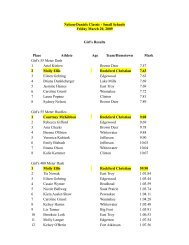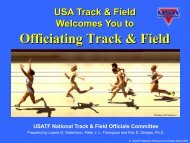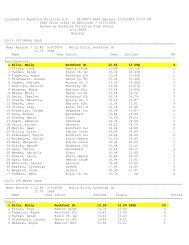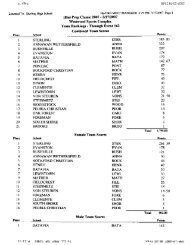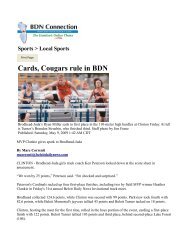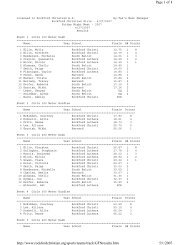Planning Technical Training for the Track and Field Athlete By: Boo ...
Planning Technical Training for the Track and Field Athlete By: Boo ...
Planning Technical Training for the Track and Field Athlete By: Boo ...
You also want an ePaper? Increase the reach of your titles
YUMPU automatically turns print PDFs into web optimized ePapers that Google loves.
<strong>Planning</strong> <strong>Technical</strong> <strong>Training</strong> <strong>for</strong> <strong>the</strong> <strong>Track</strong> <strong>and</strong><br />
<strong>Field</strong> <strong>Athlete</strong><br />
Introduction<br />
<strong>By</strong>: <strong>Boo</strong> Schexnayder<br />
Most coaches spend hours painstakingly planning every detail of <strong>the</strong> training program, <strong>and</strong> periodize <strong>the</strong>ir training with<br />
great detail. Often, not nearly as much time <strong>and</strong> ef<strong>for</strong>t is devoted to periodization of <strong>the</strong> technical plan. <strong>Planning</strong> <strong>the</strong><br />
teaching of necessary technical skills is as crucial to success as fitness levels, <strong>and</strong> should be considered just as closely. The<br />
purpose of this article is to provide guidelines <strong>for</strong> periodization of <strong>the</strong> technical training year <strong>and</strong> choosing training activities<br />
<strong>for</strong> each session.<br />
Drills <strong>and</strong> Teaching Progressions<br />
Good teaching progressions <strong>and</strong> drills are often considered a panacea in athletics, <strong>and</strong> are pursued relentlessly. Often in this<br />
pursuit, we lose sight of <strong>the</strong> actual purpose of <strong>the</strong>se activities. So often well meaning coaches want a progression of drills<br />
that, when completed, produces a technically perfect athlete. This happens rarely <strong>and</strong> only by chance.<br />
A coach should realize that a drill is not a teacher, but an opportunity to teach. Certain fundamentals should be identified<br />
prior to practice, <strong>the</strong>n taught <strong>and</strong> rehearsed within <strong>the</strong> context of <strong>the</strong> drill. The effectiveness of a drill has little to do with <strong>the</strong><br />
drill itself. Its effectiveness is determined by <strong>the</strong> skill <strong>the</strong> coach uses in identifying fundamentals <strong>and</strong> recognizing chances to<br />
teach <strong>the</strong>m in within <strong>the</strong> drill.<br />
Phases of <strong>Training</strong><br />
The technical training year should be divided into phases of training, just as we divide <strong>the</strong> year into phases in our fitness<br />
training. Be<strong>for</strong>e naming <strong>and</strong> elaborating on <strong>the</strong> content of <strong>the</strong>se phases, we should state that each is a process, not just a<br />
period of time. We break <strong>the</strong> year into <strong>the</strong>se phases <strong>for</strong> <strong>the</strong> sake of discussion, yet <strong>the</strong>se phases blend smoothly into each<br />
o<strong>the</strong>r <strong>and</strong> indicate an evolutionary process that should be unfolding.<br />
Drills <strong>and</strong> Partial Skills<br />
Generally, we should start with a period of drills <strong>and</strong> partial skills. The drills in this phase provide an opportunity to address<br />
fundamentals. The partial skills are basically just that…. <strong>the</strong> actual competitive event broken into manageable teaching<br />
portions.<br />
While this is a necessary <strong>and</strong> useful time, we must realize that <strong>the</strong> key purpose of this period is to familiarize <strong>the</strong> athlete<br />
with certain concepts so that a basic underst<strong>and</strong>ing of concepts is developed prior to bringing <strong>the</strong>m to <strong>the</strong> whole event. The<br />
purpose here is not to develop complete mastery of <strong>the</strong>m. Mastery should be developed within <strong>the</strong> event itself, <strong>and</strong> generally<br />
speaking, most programs spend far too much time in this period.<br />
Syn<strong>the</strong>sis<br />
A period of syn<strong>the</strong>sis of <strong>the</strong>se fundamentals should come next. During this period fundamentals are brought to <strong>and</strong><br />
implanted into <strong>the</strong> event. The partial skills learned are syn<strong>the</strong>sized into bigger parts <strong>and</strong> eventually a model that resembles<br />
<strong>the</strong> competitive event.<br />
This process includes not only syn<strong>the</strong>sis of <strong>the</strong>se parts, but also <strong>the</strong> increase of dem<strong>and</strong>s until <strong>the</strong> practice session involves<br />
intensities <strong>and</strong> speeds that approach those of competition. Generally speaking, <strong>the</strong> planned syn<strong>the</strong>sis period should be
complete prior to <strong>the</strong> start of <strong>the</strong> competitive season.<br />
Problem Solving<br />
Finally, a period of problem solving should be planned. Regardless of <strong>the</strong> effectiveness of <strong>the</strong> teaching <strong>and</strong> planning,<br />
problems arise. In spite of high mastery of spatial concepts in <strong>the</strong> early stages of learning, temporal <strong>and</strong> rhythmic dem<strong>and</strong>s<br />
differ, <strong>and</strong> much time must be allotted <strong>for</strong> <strong>the</strong>se adaptations.<br />
The key element of <strong>and</strong> reason <strong>for</strong> <strong>the</strong> necessity of this problem-solving period is <strong>the</strong> adaptation to competitive dem<strong>and</strong>s.<br />
Competitive dem<strong>and</strong>s are higher than those we create in practice, so technical breakdowns will occur at this point. This is<br />
why we generally associate <strong>the</strong> problem-solving period with <strong>the</strong> competitive season.<br />
Some coaches try to create competitive type situations in practice in an ef<strong>for</strong>t to prevent <strong>the</strong>se problems. These attempts<br />
usually fail, because emotional <strong>and</strong> arousal factors present in competition are seldom present in practice. For this reason, it<br />
is often best to schedule competitions so that <strong>the</strong> first few can effectively serve as very specific practices.<br />
Radical Changes<br />
One additional phase must sometimes be included. This would be a period of time <strong>for</strong> radical technical changes. Any radical<br />
change that must be accomplished should be done so that much time is available prior to competition. Thus if this phase is<br />
required, it should precede <strong>the</strong> o<strong>the</strong>r three.<br />
Drills <strong>and</strong> Phases of <strong>Training</strong><br />
It should be noted that while a drill may be very useful <strong>for</strong> teaching a particular element of technique, it may but be<br />
appropriate at all times. For example, a particular drill may be very effective <strong>for</strong> isolating <strong>and</strong> teaching <strong>the</strong> trail leg motion<br />
in <strong>the</strong> hurdles in <strong>the</strong> early stages of learning. This drill, while effective <strong>the</strong>n, would be a poor choice <strong>for</strong> fixing a fault in this<br />
area during <strong>the</strong> late competitive season because it addresses <strong>the</strong> fault outside <strong>the</strong> context of <strong>the</strong> whole movement. We must<br />
use drills <strong>and</strong> technical exercises that are appropriate to <strong>the</strong> phases of technical training above.<br />
The Overload Principle<br />
All coaches have an inherit underst<strong>and</strong>ing of <strong>the</strong> overload principle. The human organism is adaptable, but will only adapt<br />
to a stimulus to which it is unaccustomed. The dem<strong>and</strong>s of training must increase over time if increased fitness levels are to<br />
be gained.<br />
The overload principle must be considered in <strong>the</strong> learning environment as well. Each technical training session provides a<br />
stimulus. The dem<strong>and</strong>s of this stimulus must be increased over time <strong>for</strong> learning to occur <strong>and</strong> continue.<br />
Mastery of a skill is our ultimate goal, <strong>and</strong> an admirable one. Yet, mastery of a skill at a particular level cannot be attained<br />
until <strong>the</strong> level of <strong>the</strong> training stimulus has surpassed that level. Expecting mastery to occur without an increase in <strong>the</strong> level<br />
of <strong>the</strong> training stimulus is unreasonable <strong>and</strong> halts progress. When mastery is partially (but not completely) achieved, <strong>the</strong>n<br />
training stimulus should become more dem<strong>and</strong>ing so that learning will continue to occur.<br />
For example, lets consider a male shot putter in <strong>the</strong> developmental stage, throwing a lighter shot in <strong>the</strong> practice<br />
environment. Lets say that this shot putter exhibits 90 percent mastery of <strong>the</strong> skill at this level, but still exhibits a few minor<br />
faults. We could, in spite of <strong>the</strong> fact that perfection hasn’t been attained with <strong>the</strong> light shot, progress to a slightly heavier<br />
shot <strong>for</strong> a session. This would increase <strong>the</strong> intensity of <strong>the</strong> stimulus. When <strong>the</strong> athlete returns to <strong>the</strong> lighter shot, it feels<br />
more com<strong>for</strong>table than be<strong>for</strong>e, <strong>and</strong> he demonstrates a higher level of mastery than he did be<strong>for</strong>e working with <strong>the</strong> heavier<br />
shot.<br />
Of course, a high degree of mastery is required be<strong>for</strong>e we increase <strong>the</strong> dem<strong>and</strong>s as such. We can, just as we can in training,<br />
increase dem<strong>and</strong>s <strong>and</strong> difficulty too quickly. But, to expect mastery without any such increase is unreasonable. We must<br />
realize that <strong>the</strong> increase in training dem<strong>and</strong>s will always precede an increase in mastery.
This increase in dem<strong>and</strong> should be progressive, <strong>and</strong> may take many <strong>for</strong>ms. Heavier implements, more complex exercises,<br />
longer approach runs, <strong>and</strong> increased velocities. Are common tools coaches may use to achieve this overload.<br />
Whole vs. Part Practice<br />
We have briefly commented earlier separately about partial learning <strong>and</strong> syn<strong>the</strong>sis. Lets now examine <strong>the</strong>se activities by<br />
contrasting <strong>the</strong>m. The debates over <strong>the</strong> benefits of whole practice <strong>and</strong> partial practice have raged <strong>for</strong> some time, <strong>and</strong> will<br />
continue.<br />
Partial practice serves as a more controlled, effective atmosphere <strong>for</strong> teaching rudimentary concepts, but <strong>for</strong> <strong>the</strong> beginner it<br />
may be confusing, as it is tough <strong>for</strong> a beginner to see how <strong>the</strong> skill fits in. Whole practice presents such a great number of<br />
variables that coaching purely within this context (be<strong>for</strong>e some underst<strong>and</strong>ing of rudimentary skills is established) may be<br />
confusing.<br />
Yet, it is inarguable that whole practice is more specific <strong>and</strong> more dem<strong>and</strong>ing. There<strong>for</strong>e, if <strong>the</strong> dem<strong>and</strong>s of <strong>the</strong> practice<br />
stimulus are to be increased, whole practice has a valuable place in <strong>the</strong>se training schema.<br />
Variety in Practice<br />
Motor learning research tells us much about variance in <strong>the</strong> practice environment. While variety in practice may not<br />
improve per<strong>for</strong>mance in practice, variety in <strong>the</strong> practice environment does improve per<strong>for</strong>mance in competition. Variety in<br />
training <strong>for</strong>ces <strong>the</strong> athlete to adapt in a variety of ways, learning to deal with a greater variety of situations <strong>and</strong> becoming<br />
better at adaptation itself. Variance in <strong>the</strong> practice environment is necessary to foster a conducive learning atmosphere.<br />
The increase in dem<strong>and</strong>s of <strong>the</strong> stimulus we have just discussed is just one <strong>for</strong>m of this. O<strong>the</strong>rs must be used in order to<br />
maximize <strong>the</strong> learning achieved in <strong>the</strong> time available. Changing <strong>the</strong> drills used, exercise choice, approach run length,<br />
implement weight, hurdle height, drill sequence, or location in <strong>the</strong> training regimen can all be used to create this variety.<br />
This does not mean an infinite number of drills <strong>and</strong> exercises must be taught. Using certain ones <strong>for</strong> a period of time, going<br />
on to o<strong>the</strong>rs, <strong>the</strong>n returning to <strong>the</strong> original ones can be sufficient.<br />
Scheduling of <strong>the</strong>se changes can take many <strong>for</strong>ms. They may be altered in a cyclic fashion on a daily, weekly, <strong>and</strong> or<br />
monthly basis. For example, lets assume that we will schedule two triple jump technical training sessions per week. For one<br />
month, <strong>the</strong> first session could consist of triple jumping from a seven step approach. The second could consist of drills that<br />
are different from but related to <strong>the</strong> event, such as various combinations of bounds. During <strong>the</strong> next month, <strong>the</strong> first session<br />
could consist of triple jumping again but from a longer nine step approach. The second could be a review session of<br />
remedial drills done earlier in <strong>the</strong> training year.<br />
Purposes of Practice<br />
One goal of technical training practice is obvious. Its purpose is to teach <strong>and</strong> perfect <strong>the</strong> execution of <strong>the</strong> skill. Generally<br />
speaking, with developmental athletes, <strong>the</strong> first part of <strong>the</strong> training year is dedicated to teaching this skill to a level that will<br />
enable <strong>the</strong> athlete to execute it flawlessly under <strong>the</strong> dem<strong>and</strong>s of competition.<br />
There is a second goal however, <strong>and</strong> an often neglected one. Once <strong>the</strong> skill is taught, what are we trying to accomplish with<br />
<strong>the</strong>se practices <strong>the</strong> remainder of <strong>the</strong> year? These practices provide an opportunity <strong>for</strong> coaches to develop <strong>and</strong> rehearse cues<br />
<strong>the</strong>y will give <strong>the</strong>ir athletes during competition <strong>and</strong> examine athlete’s responses to <strong>the</strong>m. These practices give athletes an<br />
opportunity to practice responses to <strong>the</strong>se cues <strong>and</strong> develop underst<strong>and</strong>ing of <strong>the</strong>m. In short, <strong>the</strong> goal of <strong>the</strong>se practices, once<br />
<strong>the</strong> skill is learned, is to rehearse athlete-coach communication during competition.<br />
It is important that we keep this second goal in mind later in <strong>the</strong> season. As important competitions approach, a wise is using<br />
past competition experience to determine what problems are likely to arise, <strong>and</strong> is, with <strong>the</strong> athlete, developing dialog <strong>and</strong><br />
cues in practice to h<strong>and</strong>le <strong>the</strong>se situations.<br />
Contrast in <strong>the</strong> Practice Environment<br />
As stated earlier, <strong>the</strong> earlier parts of <strong>the</strong> training year is devoted to teaching <strong>the</strong> skill, <strong>the</strong>n preparing <strong>the</strong> athlete to execute it<br />
under <strong>the</strong> dem<strong>and</strong>s of competition. We also stated that <strong>the</strong> goals later shift to a rehearsal of meet dialog, cues, <strong>and</strong> responses.<br />
During this time, since <strong>the</strong> purpose of practice changes, so must <strong>the</strong> intensity of <strong>the</strong> practice stimulus.
Sometimes, skills are so similar that <strong>the</strong> body becomes confused <strong>and</strong> finds it difficult to effectively shift from one skill to<br />
ano<strong>the</strong>r while executing both well. At this time of year, ideally <strong>the</strong> athlete is keenly attuned to competitive velocities <strong>and</strong><br />
intensities. Velocities <strong>and</strong> intensities in practice that are only slightly different than those in competition only serve to<br />
confuse.<br />
For this reason, it is best to provide a sharp contrast in intensities between practice <strong>and</strong> competition. Slower practice<br />
velocities <strong>and</strong> lower practice intensities still provide an opportunity to develop <strong>and</strong> rehearse cues <strong>and</strong> responses. At <strong>the</strong> same<br />
time, <strong>the</strong> different velocity enables <strong>the</strong> body to interpret practice <strong>and</strong> <strong>the</strong> meet as differing skills, ra<strong>the</strong>r than similar ones<br />
that interfere with each o<strong>the</strong>r.<br />
For example, a pole vaulter may spend time vaulting from an 18 step, meet length approach in practice in <strong>the</strong> weeks prior to<br />
<strong>the</strong> start of <strong>the</strong> competitive season, <strong>and</strong> will probably continue to do so <strong>for</strong> a few weeks after <strong>the</strong> season has started. At some<br />
time, however, having <strong>the</strong> vaulter practice from a 10 step approach would provide contrast to <strong>the</strong> meet approach <strong>and</strong><br />
minimize interference. The vaulter could continue to practice <strong>the</strong> competition approach in a different manner, drilling<br />
without a takeoff or with a sliding box, <strong>for</strong> example.<br />
It is important to note that <strong>the</strong> decrease in intensity advocated here pertains only to specific technical training sessions, not<br />
to <strong>the</strong> remainder of <strong>the</strong> athlete’s fitness training regimen.<br />
Conclusion<br />
In closing, <strong>the</strong> acquisition of technical skill is often by chance. Proper planning <strong>and</strong> applying <strong>the</strong> principles of training<br />
<strong>the</strong>ory to <strong>the</strong> motor learning field can result in much more effective teaching in much shorter periods of time.



